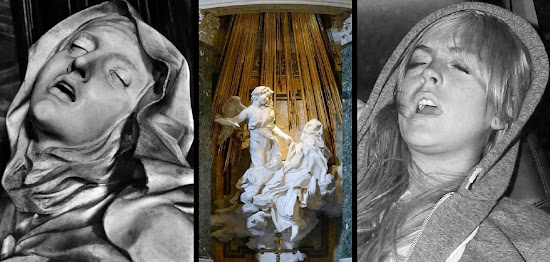Baroque
(pronounced buh-rohk or ba-rawk (French)).
(1) Of or relating to a style of architecture and
art originating in Italy in the early seventeenth century and variously
prevalent in Europe and the New World for a century and a half, characterized
by free and sculptural use of the classical orders and ornament, by forms in
elevation and plan suggesting movement, and by dramatic effect in which architecture,
painting, sculpture, and the decorative arts often worked to combined effect (often
used with an initial capital letter).
(2) In music, of or relating to the period
following the Renaissance, extending (circa 1600-1750) which tended to be
characterized by extensive use of the thorough bass and of ornamentation to
create dramatic effects. Johann Sebastian Bach, George Frederick Handel, and
Antonio Vivaldi were great composers of the baroque era.
(3) In literature, a style of prose thought extravagantly
ornate, florid, and convoluted in character or style.
(4) An irregularly shaped pearl (rare except in
technical use).
(5) In pre-modern twentieth century design or
engineering, objects intricately or ornately detailed in a way no longer financially
viable.
(6) Descriptively (of any object where the
technical definitions don’t apply), variously (1) ornate, intricate, decorated,
laden with detail & (2) complex and beautiful, despite an outward irregularity.
(7) In stonemasonry & woodworking, chiselled
from stone, or shaped from wood, in a garish, crooked, twisted, or slanted sort
of way, grotesque or embellished with figures and forms such that every level
of relief gives way to more details and contrasts.
(8) Figuratively, something overly or needlessly
complicated, applied especially to bureaucracy or instances like accounting systems
which either are or appear to be designed to conceal or confuse.
1765: From the French baroque (originally “pearl of irregular shape”), from the Portuguese
barroco or barroca (irregularly shaped pearl) which was in some way influenced
by either or both the Spanish berrueco
or barrueco (granitic crag, irregular
pearl, spherical nodule) and the Italian barocco,
of uncertain ultimate origin but which may be from the Latin verrūca (wart). The etymology is however murky and some
suggest the Portuguese words may directly have come from the Spanish berruca (a wart) also from the Latin verrūca (a steep place, a height (and
thus “a wart” or “an excrescence on a precious stone”). Most scholars think at some point it probably
conflated with Medieval Latin baroco,
an invented word for a kind of obfuscating syllogism although one speculative alternative
is the word was derived from the work of the Italian painter Federigo Barocci
(1528-1612), a founder of the style, but most think this mere coincidence. The comparative is baroque and the superlative
baroquest, both thankfully rare. Baroque
is a noun & adjective, baroqueness is a noun and baroquely is an adverb,
the noun plural is baroques.

Marble Court, Palace of Versailles. Commissioned in the 1660s by Louis XIV
(1638–1715; le Roi Soleil (the Sun King), King of France 1643-1715), the Palace
of Versailles is thought one of the the finest example of secular Baroque
architecture.
Baroque is one of those strange words in English which
has evolved to have several layers of meaning including (1) a term which
defines epochs in music & architecture, (2) a term referencing the characteristics
in the music & architecture most associated with those periods, (3) a term
which is a negative criticism of those characteristics, (4) a term which is (by
extension) a negative criticism of the excessively ornate in any field (especially
in literature) and (5) a term applied admiringly to things intricately or elaborately
detailed. In English, baroque began as
an expression of contempt for the style of architecture which most historians
believe began in early seventeenth century Rome and which shocked many with its
audacious departure from the traditions of the Renaissance which paid such
homage to (what was at least imagined to be) the Classical lines from
Antiquity. In architecture, baroque has
never been exactly defined, something some explain by analogy with Clement
Attlee’s (1883–1967; UK prime-minister 1945-1951) observation that it was as pointless
to define socialism as it was an elephant for “...if an elephant ever walked into
the room, all would know what it was”.

Karlskirche, Vienna.The Vatican's Saint Peter’s
Square is often used to illustrate Baroque architecture and all those
colonnades do make quite a statement but Vienna's Karlskirche better
represents the way church architects took to the form. It was commissioned in 1713 by Charles VI
(1685–1740; Holy Roman Emperor 1711-1740) after the end of the last great
epidemic of Plague as an act of memorial to Cardinal Carlo Borromeo (1538-1584;
Archbishop of Milan 1564-1584), revered as a healer of those suffering from
Plague.
Actually, although etymologists would say that's true, that’s not how the word is actually often applied because the
terms baroque and rococo are often used interchangeably by non-specialists when
speaking of just about any building adorned with the elaborate details not seen
since modernism, functionalism & brutalism prevailed. What distinguishes things is less the actual shapes
than the feeling imparted, baroque and rococo both noted for asymmetry, luxuriant
detailing, extravagant, unexpected curves & lines and a polychromatic
richness but where baroque’s language is of grandeur, weight & monumentalism,
rococo’s implementations summon thoughts of lightness, playfulness and frivolity. Tellingly, rococo, when used as a critique is
applied almost always in the negative, suggesting something fussy, pointlessly
elaborate and overstated whereas baroque is often used admiringly, literature about
the only field in which use is universally negative. The other common use of baroque in the
negative applies to bureaucracy or tangled administrative systems when it’s
used as a synonym of byzantine. For
those seeking a rule of thumb, except in literature, baroque tends not to be
used negatively and when describing objects which contain ornate or intricate
detailing, it’s adopted usually to suggest something complex and beautiful,
despite an outward irregularity. Baroque
suggests restraint and good taste (there are many other words with which to
describe the garish, crooked, twisted or grotesque) and to damn something as
silly, over detailed and laden with decorations with no functional or aesthetic
purpose, there’s rococo.

Winter Palace, Saint Petersberg. Some do find the Winter Palace a bit rococo
and there are elements of that in the interior but architecturally, it's an
example of early baroque, albeit much modified by later renovations. It was built as a residence of Peter the
Great (Peter I, 1672-1725; Tsar of Russia 1682-1725) and remain an official
palace of the Romanov Tsars between 1732 and the 1917 revolutions. The present appearance reflects both the
restorative work of the late 1830s when it was rebuilt after a severe fire and
the restoration after the damage suffered during the Siege of Leningrad
(1941-1944).
The use in the language of literary criticism is,
like any application of “baroque” in the non-visual arts, inherently
imprecise. Even in music, it’s understood
as a period and many of the compositions which emerged from the era do have a
style which is recognisably “baroque” but there was also much which was
anything but. The same can of course be
said of the European buildings of the same period, the overwhelming majority of
which were neither “baroque”, nor memorable, the adjective in what is now
called the “built environment” making sense only when used of representational architecture. That’s a well-understood distinction in
architecture and even painting but more contentious in music, something made
murkier still by musicologists having divided the baroque into the “early”, “middle”
and late”, mapped onto a range of styles which were sometimes particular to one
country and sometimes popular in many.
Interestingly, although as a generalized descriptor it needs still to be thought
of as something which began as a term of derision in architecture (and it is
from there it gained its parameters), there is an earlier, anonymous piece of
(not especially serious) opera criticism which labelled a work as du barocque (in the sense of the original
meaning “pearl or irregular shape”), damning the music as un-melodic,
discordant and a roll-call of just about every known compositional device;
something more like a student’s assignment than a opera. It’s a critique not greatly different from
that made some three centuries later by comrade Stalin (1878–1953; leader of
the USSR, 1924-1953) who’d been displeased by one of comrade Dmitri Shostakovich’s
(1906-1975) operas, calling it формализм (formalism), "chaos instead of music", a
self-indulgence of technique by a composer interested only in the admiration of
other composers.

L'Estasi
di Santa Teresa (The Ecstasy of Saint Teresa) by Gianlorenzo Bernini
(1598–1680) is a sculptural group rendered in white marble, set in an elevated
aedicule in the Cornaro Chapel of the church of Santa Maria della Vittoria in
Rome. It’s thought one of the sculptural
masterpieces of the High Roman Baroque and depicts Teresa of Ávila, a Spanish
Carmelite nun and saint, in a state of religious ecstasy, a spear-holding angel
watching over her. The installation in
2007 (briefly one supposes) gained baroque sculpture a new audience when it was used in a popular meme
which noted some similarity with an early morning photograph of Lindsay Lohan
resting in a Cadillac.

The
last days of baroque: 1967
Mercedes–Benz 600 Pullman Laudaulet (left & rght) and 1971 Mercedes-Benz 280 SE 3.5
Cabriolet (centre). There was intricate
detailing on the W111 and W100s, the last truly coach-built Mercedes-Benz. Most were produced between 1963-1971 although
the W100s continued in a trickle, substantially hand-built, until 1981.
Jean-Jacques Rousseau (1712–1778), remembered as
the philosopher who loomed over the French revolution, was also a composer and
in his Dictionnaire de la musique (Dictionary
of Music, 1767) declared baroque music to be that “...in which the harmony is
confused, and loaded with modulations and dissonances. The singing is harsh and
unnatural, the intonation difficult, and the movement limited...”, noting the term
was a re-purposing of baroco (an alternative spelling of baroko (from a mediaeval mnemonic chant and a mode of syllogism used whenever some point seemed to be exist only pointlessly to obfuscate), used
since the thirteenth century by philosophers discussing the tendency by some of
their peers (usually those in the Church or university) needlessly to complicate
simple concepts and arguments, just for the sake of grandiose academic gloss;
formalism as it were. Etymologists
however remain unconvinced by Rousseau’s speculation and cite earlier evidence
which suggests it was from architecture that the use in painting and music was
derived, pondering that had Rousseau’s musicology been influenced by him being
an architect rather than a philosopher, he too may have identified the source
in brick and stone. Anyway, baroque
music as it’s now understood is a surprisingly recent construct, discussed as a
thing only in the twentieth century, the term widely used only after the 1950s
when the advent of long-playing (LP) records made the packaging and
distribution of long-form composition practical and the industry became
interested in categorizations, the Baroque something different from the Renaissance
and the Classical despite the popular association of them all as one.





















